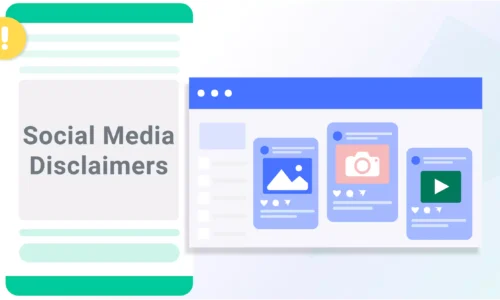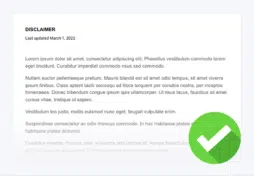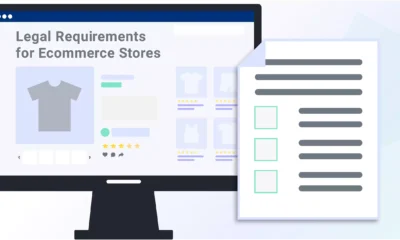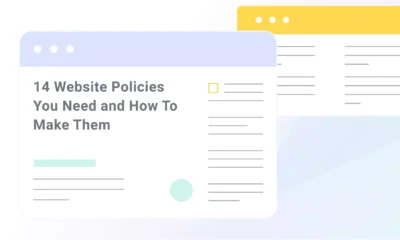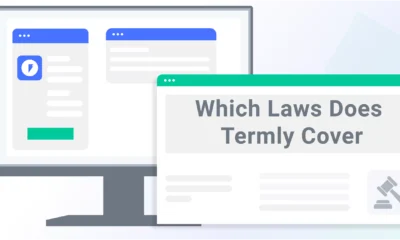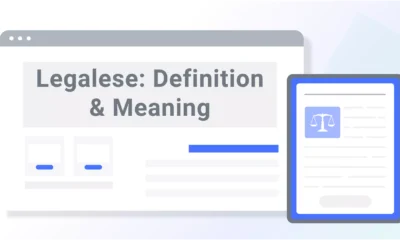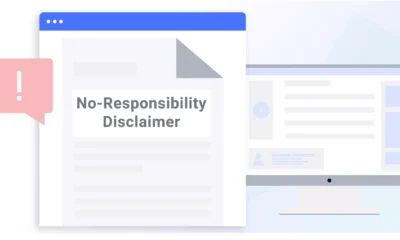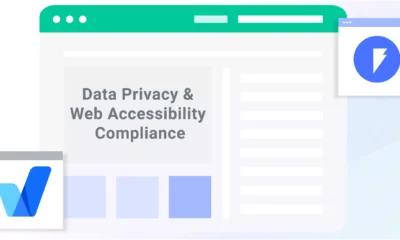Social media is a powerful business tool, but without the right disclaimers, it can expose you to legal risks.
In this article, I’ll explain the different types of social media disclaimers, how to write them, where to post them, and more to help you safeguard your business online.
Social Media Disclaimer Solutions
First, I’ll dive into the methods you can use to create social media disclaimers, including Termly’s generator, templates, and guidelines for writing your own.
Managed Solution
Using a managed solution is the easiest way to make social media disclaimers.
You can use Termly’s Disclaimer Generator, which offers an automated way to create customized social media disclaimers.
The generator walks you through a series of questions to create a disclaimer that fits your specific needs so you can avoid legal risk and focus on engaging your audience.
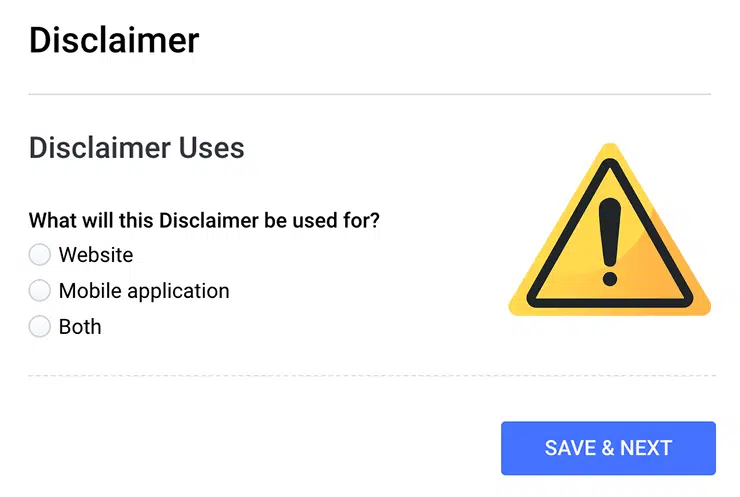
Template
If you prefer a ready-made template for your social media disclaimer, Termly offers a customizable disclaimer template.
It includes key sections like copyright disclaimers and affiliate disclosures. All you need to do is manually replace the text that appears in [brackets] with information about your businesses.
I’ve provided an example of what the template looks like below.
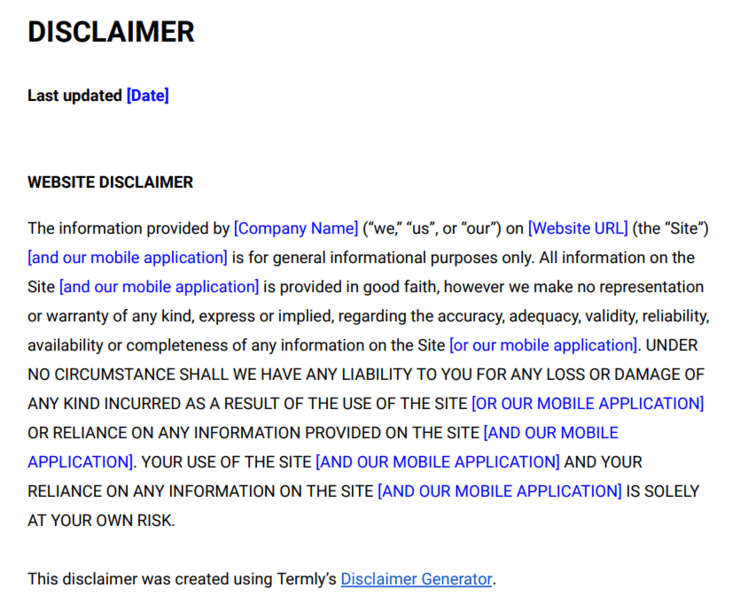
For more information, check out Termly’s Disclaimer Template guide.
How To Write One Yourself
You can also write your disclaimers on your own.
When writing your own social media disclaimer, there are a few key considerations to ensure it’s effective and legally compliant.
- Identify the purpose. Clearly define the goal of your disclaimer. Are you protecting intellectual property, informing users about affiliate relationships, or distancing your personal views from your employer?
- Include legal requirements. You may need to include specific legal language, such as copyright notices, affiliate disclosures, or fair use statements. Ensure your disclaimer meets applicable regulations.
- Be clear and direct. Avoid vague language. State your expectations clearly, such as “The views expressed are my own and not those of my employer.”
By considering these factors, you can make a social media disclaimer tailored to your needs.
What Are Social Media Disclaimers?
A social media disclaimer is a statement or set of rules posted on social media platforms to help reduce legal risks and protect your brand.
They can serve multiple purposes, including:
- Protecting copyrighted material.
- Disclosing affiliate relationships.
- Clarifying that the views shared are personal and not official company positions.
Some businesses may also create a dedicated page on their website that outlines the rules for user interactions on their social media pages.
Companies set clear expectations and limit potential liabilities by including these disclaimers.
Laws That Require Social Media Disclaimers
While social media disclaimers aren’t generally required, there are certain situations where they are legally necessary. Here are some key instances where disclaimers are needed:
- Federal Trade Commission (FTC) – Requires disclosure when promoting products for compensation or using affiliate links. Use terms like “ad” or “sponsored” to inform your audience. The FTC mandates that affiliate disclosures (e.g., ‘ad’ or ‘sponsored’) must be placed at the beginning of posts or video descriptions, not hidden in hashtag lists.
- U.S. Copyright Law – Protects original content. Use a copyright disclaimer to assert ownership. If using copyrighted material under fair use, include a disclaimer clarifying your use.
- Security and Exchange Commission (SEC) – Requires disclaimers for investment-related content, stating it is informational only and not professional financial advice. Paid endorsements must also disclose compensation and financial interests.
- General Data Protection Regulation (GDPR) – EU law that requires consent for collecting data. If you’re collecting data through social media platforms, make sure you include information about data usage.
- Digital Markets Act (DMA) – While primarily targeting large platforms, this EU law enforces transparency in advertising, compelling gatekeepers to provide users with clear information about how their data is used for ad targeting.
- Digital Markets, Competition and Consumers Bill – UK law that aims to regulate the digital market, introducing rules regarding subscription contracts, “drip pricing,” and fake reviews. The proposed UK Digital Markets, Competition and Consumers Bill aims to regulate fake reviews and subscription practices. If passed, businesses may need to update disclaimers to address these rules.
Real-World Examples of Disclaimers That Failed
Disclaimers help manage risk, but not if they fail to meet regulatory standards.
I included two cases below to show why understanding the laws behind disclaimers is critical.
Kim Kardashian’s $1.26 Million SEC Fine (2022)
What happened?
Kim Kardashian promoted a cryptocurrency investment on Instagram using “#ad.” The SEC fined her $1.26 million for failing to disclose that she was paid $250,000 for the post.
Why did her disclaimer fail?
The SEC requires explicit disclosure of compensation for financial endorsements.
She also didn’t state that crypto investments carry risk or provide a disclaimer that it wasn’t financial advice.
FTC Targets Dietitians and Health Influencers (2023)
What happened?
The FTC sent warning letters to two trade associations — The American Beverage Association and The Canadian Sugar Institute — and twelve registered dietitians and health influencers for promoting artificial sweeteners and sugar without clear sponsorship disclosures.
Why did their disclaimers fail?
Some posts relied on vague hashtags like “#sponsored” or “#ad” while others had no disclosures at all.
In other cases, disclosures were buried in captions or required users to click “more.”
Both of these cases highlight that vague, hidden, or incomplete disclaimers can lead to penalties. It’s important to understand the extent of the laws that apply to your business with regard to social media activity.
Who Needs a Social Media Disclaimer?
While not always required, social media disclaimers can benefit any business with an online presence. Let’s look at some different scenarios where you might consider using them.
Disclaimer for Posting on Social Media
If you frequently post content, you might need disclaimers related to copyright, fair use, and affiliate marketing.
Here are some sample templates for each:
- Copyright disclaimer: “© 2025 [Your Business Name]. All Rights Reserved. Unauthorized use, reproduction, or distribution of this content is prohibited.”
- Fair use disclaimer: “This content is used under fair use principles for educational purposes. Copyright belongs to the respective owners.”
- Affiliate marketing disclaimer: “This post contains affiliate links. If you purchase through these links, we may earn a commission at no additional cost to you. Thanks for supporting our content.”
Social Media Disclaimer for Employees
If your employees represent your company on social media, it’s a good idea to have a disclaimer stating that the views shared are their own and not the official company positions.
You might say:
“The opinions expressed here are my own and do not reflect the views of my employer, [Company Name].”
While disclaimers like ‘Views are my own’ help distinguish personal opinions from employer stances, companies should also implement social media policies and training to mitigate risks.
In the realm of social media management, it’s equally important to establish clear guidelines for content approval workflows and brand messaging to ensure that all posts align with the company’s values and avoid potential conflicts.
Dedicated Social Media Disclaimer Page
Some businesses opt for a dedicated social media disclaimer page on their website outlining:
- Community guidelines.
- Rules for user interactions.
- Consequences for violating the rules.
You might say:
“By interacting with our social media pages, you agree to adhere to our community guidelines.”
Disclaimer To Remove Liabilities
Social media disclaimers also serve to remove liabilities.
You can protect your business from unwanted behavior and potential lawsuits by clearly stating that users who engage with your social media accounts by posting original content must follow specific rules.
You might say:
“[Business Name] is not responsible for any user-generated content. By engaging with this page, you agree to follow our community guidelines.”
Social Media Disclaimer Examples
Next, I’ve provided some examples of social media disclaimers in action.
Copyright Disclaimer Example
The screenshot below shows an example of a copyright disclaimer in the description of the YouTube music video for Lady Gaga’s song “Abracadabra.”

In this case, the official Lady Gaga YouTube channel has included a copyright notice stating that the rights to the song and video belong to the artist and her record label.
I like this because it clearly establishes ownership and informs listeners that the content cannot be used, copied, or redistributed without permission.
Fair Use Disclaimer Example
Many YouTube channels that post commentaries, reviews, or media analyses include fair use disclaimers to clarify their use of copyrighted material.
I found a great example of this in the description of BoltMotivation’s YouTube Short on The Queen’s Gambit.
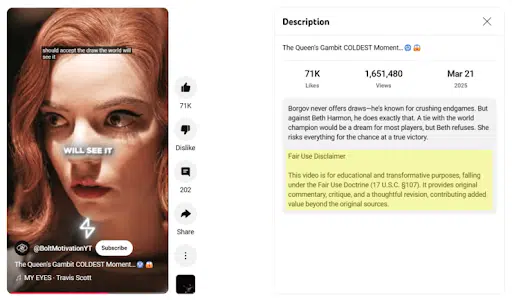
In the description, BoltMotivation indicates that the video is for “educational” purposes, reducing the risk of copyright claims.
Though there is no guarantee against enforcement, disclaimers like this signal the creator’s awareness of fair use protections.
Social Media Disclaimer for Employees Example
Now, I’ll show you an example of a disclaimer used by an employee.
Clarissa Ward, CNN’s Chief International Correspondent, includes a “views expressed” disclaimer in her X (formerly Twitter) bio, highlighted in the screenshot below.
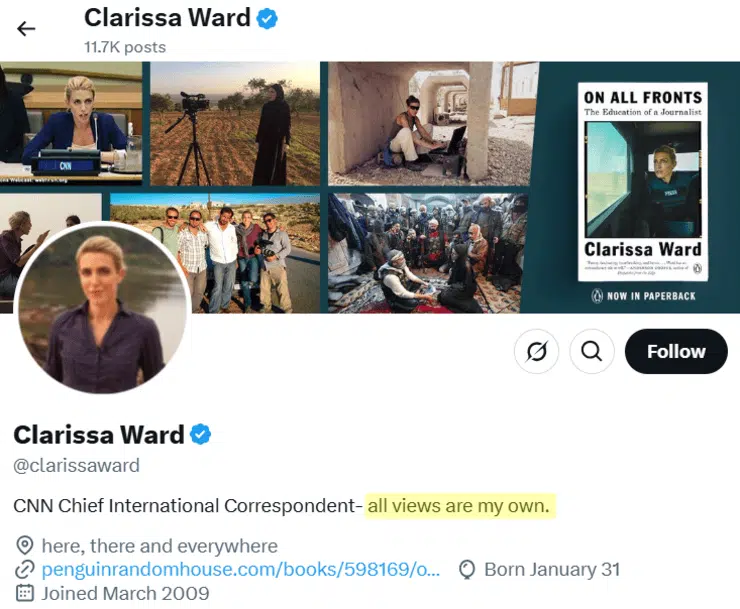
Ward’s disclaimer clarifies that her posts reflect her personal opinions, not CNN. Corporate employees often use similar disclaimers to differentiate their views from those of their employer.
In this case, it is especially important because Ward holds a high-profile position at a reputable news organization, where personal statements could be misinterpreted as official company positions.
While not legally binding, this type of statement helps set boundaries between personal commentary and professional affiliation.
Dedicated Social Media Disclaimer Page Example
Organizations include a dedicated social media disclaimer page on their website to set clear guidelines for user interactions and protect against potential liabilities.
An example of this comes from Integrity Behavioral Health Psychiatry & Psychotherapy’s Social Media Disclaimer, which outlines the expectations for user behavior and content sharing.
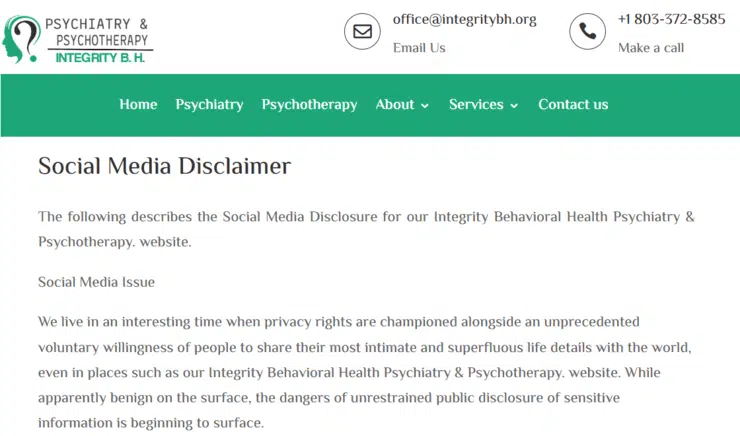
Their disclaimer addresses key concerns, including:
- Privacy Risks – Warns against sharing sensitive personal information.
- User responsibilities – Advises caution when posting about third parties.
- Content accuracy – States that user-generated content may not be factual.
- Liability – Clarifies the organization is not responsible for user posts.
Implementing a dedicated social media disclaimer page is a proactive measure for organizations to manage their online presence more effectively.
Where to Post Social Media Disclaimers
Disclaimers should be easy to find and visible to your users, with the best placement depending on the type of disclaimer and platform.
Social Media Bios
Placing a disclaimer in your bio section is ideal for individuals or employees who want to clarify that your opinions do not reflect your employer’s stance.
Website Footer
Placing a link in the footer of your website directing users to dedicated social media disclaimers ensures transparency.
Dedicated Social Media Disclaimer Page
Having a dedicated social media disclaimer page is the most comprehensive way for businesses and organizations to establish guidelines for engagement and liability.
Terms & Conditions
Integrating disclaimers into your Terms & Conditions provides legal coverage by clearly outlining the rules, responsibilities, and limitations of liability for both your company and users.
Social Media Posts & Descriptions
For content creators, reviewers, and affiliate marketers, adding disclaimers directly in social media post captions or descriptions helps with legal compliance.
Tips for Enforcing Social Media Disclaimers
Below are some tips for effectively enforcing your social media disclaimers.
Tip #1: Make Disclaimers Easy To Find
Don’t bury your disclaimers in fine print or an obscure webpage where users may not see them.
Review the previous section I included to determine the best locations to place your social media descriptions.
Tip #2: Set Clear Community Guidelines
Social media disclaimers should work alongside your social media community guidelines that outline expected behavior, prohibited content, and consequences for violations.
Tip #3: Regularly Monitor and Moderate Content
Disclaimers won’t prevent all legal issues, so businesses should actively monitor their social media for content that could lead to disputes.
Tip #4: Ensure Legal Compliance
If your social media involves affiliate marketing, sponsored content, or data collection, disclaimers should align with regulations like the FTC and the GDPR.
Summary
Social media disclaimers help protect you from legal risks by clarifying ownership, liability, and compliance requirements.
Whether you’re a business owner, content creator, or employee, having a clear disclaimer can help safeguard your online presence.
Now, it’s time to take action!
Termly’s Disclaimer Generator helps create disclaimers aligned with major regulations like the FTC and the GDPR. We urge you to consult legal counsel to ensure you fully satisfy all applicable legal standards.
Reviewed by Masha Komnenic CIPP/E, CIPM, CIPT, FIP Director of Global Privacy


